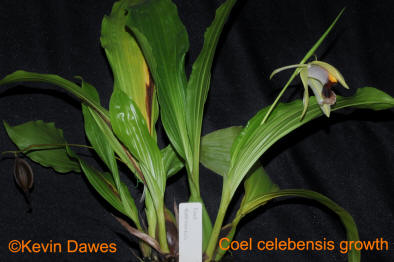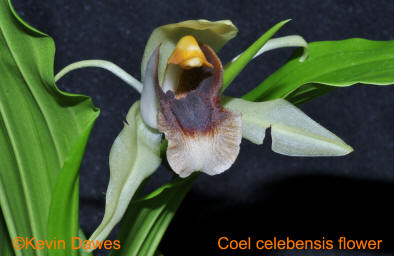Coelogyne celebensis has a very beautiful flower similar to the spectacular Coelogyne usitana and produces up to seven large, sequentially opening flowers over a period of many weeks. Its very strong point is that these flowers are on very long stems and as these grow older they can be staked in an upright style and then can open so that they are nicely visible compared to the droopy habit of Coelogyne usitana. The dark chocolate lip and bright orange on the column are striking. The sepals and petals are a very light white/green colour on this neat compact, clumping orchid.
Coelogyne celebensis is named after the Indonesian island Celebes near Bali but which is now known as Sulawesi. It is found in forests and along roadsides from sea-level up to about 1000 metres.
For warmer areas this Coelogyne has great hybridising potential because of its upright flowering habit, the large flowers and the very dark lip.
Cultivation Suggestions: It is warm to hot growing and needs high humidity and absolute protection from frosts in cooler areas, preferably in a glasshouse. Sulawesi Island has a very tropical climate! Check its high temperatures and heavy rainfall. However, given the right conditions (really good drainage) it will grow rapidly and flower very regularly. It's a good idea to stake the flowers as they get longer to prevent the spike falling over with the big flower weight.
Negatives: This fairly large plant only flowers once per year and has no perfume. It can't tolerate frosts and needs to be in glasshouse in most areas.
Rating: ♦♦♦♦ This is a very attractive Coelogyne
Sometimes sold as: No other labels
Varieties: None known
Hybrids: Note the very dark brown pod to the far left on the image above. Most Coelogynes have bright green pods (which take 11 or 12 months to ripen).
1. Coelogyne Kirribilli Carmel (Kevin Dawes 2016) using Coelogyne usitana as the pollen parent.
2. Coelogyne Kirribilli Janet Dixon-Smith (Kevin Dawes 2017) using Coelogyne mooreana 'Brockhurst' as the pod parent.
3. Coelogyne Kirribilli Raelene (Kevin Dawes 2016) using Coelogyne speciosa as the pod parent.
4. Coelogyne Janet Dixon-Smith (Kevin Dawes 2017) using Coelogyne mooreana 'Brockhurst' as the pod parent
| < Coel carinata | Coel chloroptera > |

